Sport in Australia
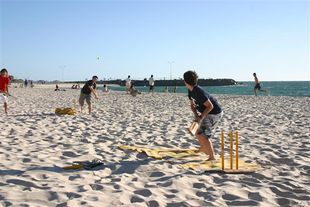
Sport in Australia is popular and widespread. Testament to this is the level of achievement in the Olympic Games and Commonwealth Games as well as other international sporting events in comparison to the population of the country, particularly in the areas of water sports and team sports. The climate and economy provide ideal conditions for Australians to participate and watch sports.
In 2000-01, total government funding for sport and recreation activities was $2,124.2 million (A$). Of this, the Commonwealth Government contributed $19.89 million (9%), state and territory governments contributed $875.2 million (41%) and local governments provided $1,050.1 million (49%).[1] The Australian Sports Commission (ASC) is the federal government body responsible for distributing funds and providing strategic guidance for sporting activity in Australia and operates the Australian Institute of Sport. Each state and territory in Australia also have agencies responsible for sport and recreation policy. Each state and territory also operation their own institutes and academies of sport.
Throughout the country a wide variety of sports are played. According to official government statistics, in 2005–06, the most popular sports in terms of crowd attendance were Australian rules football, horse racing, rugby league, motorsport, cricket, rugby union and soccer (association football) in descending order.[2] Research by a marketing company found that those attracting the "most interest" among adults in capital cities during 2006-07 were cricket, swimming, tennis, Australian rules football, soccer, rugby league, rugby union and motor sport.[3] According to official statistics, the most popular forms of "physical recreation activity" among Australians aged 15 years and over, in 2005-06 were walking, aerobics/fitness, swimming, golf, tennis, soccer and Australian rules football.[4] According to some sources, the cultural significance and long history of cricket in Australia means that it is a de facto "national sport".[5][6] Armchair sports fans drive high television ratings for sports programmes. In fact, nine of the top 10 highest rated shows in 2005 were sports programmes. The most watched sport on Australian television is rugby league with an aggregate audience of 128.5 million viewers in 2009.[7]
Such is the Australian population's devotion towards sport that it is sometimes humorously described as "Australia's national religion".[8] Popular comedic identities such as The Twelfth Man and Roy and HG send up Australia's love of sport through the use of parody.
Professional sport leagues in Australia use a model based on franchises and closed league membership, as is standard in North America. The "European" system of professional sports league organisation, characterised by promotion and relegation, is foreign at professional level though used widely in amateur competitions.
In October 2007, the Australian Government has announced a new drug policy for sport that it hopes will be adopted by all sporting bodies and will involve tests of 6000 illicit drugs a year.[9]
Athletics (Track and field)
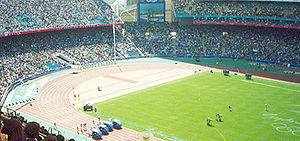
Athletics is a minor sport in Australia, with around 34,000 athletes, officials and coaches currently registered with the national association[10].
The governing body, Athletics Australia (AA) was instituted in 1897, with men's and women's associations amalgamating in 1978[11]. Each year, AA conducts the Australian Championships and the Athletics Grand Prix Series, which are the main avenues for Australian athletes to qualify for the Olympic Games, Commonwealth Games and World Championships[12].
Australia has hosted many important athletics competitions, including the 1956 and 2000 Olympic Games, the 1938, 1962, 1982 and 2006 Commonwealth Games, the 1985 World Cup in Athletics, and the 1996 World Junior Championships.
The Stawell Gift, run over the Easter weekend since 1878, is the highlight of the professional athletics calendar[13].
Australian rules football
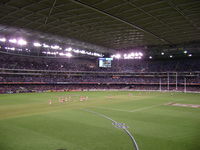
Australian rules football is played in all Australian states and territories. The game is referred to as football, "footy", "Aussie rules" or (erroneously) as "AFL", after the sport's dominant governing body and competition, the Australian Football League. In 2008 AFL games had a cumulative attendance of 7,083,015, a record for the competition and an average attendance of 38,295.[14] AFL games have the fourth-highest average attendances in the world for a domestic professional league in any sport, and third among all football codes. (In this respect they are surpassed only by the NFL, the Indian Premier League in Twenty20 cricket, and German Bundesliga.)
A 2007 estimate claimed that Australian football had 615,549 participants,[15] an addition of nearly 34,000 participants since 2006, and 6.7 per cent of all participants are from non-English speaking origin. The Australian Sports Commission statistics show a 42 per cent increase in the total number of participants over the 4 year period between 2001 and 2005.[16]
Football is the predominant winter sport in South Australia, Tasmania, Victoria, Western Australia and Northern Territory.
Each state has its own local league, and there are amateur recreational, children's, junior, masters and women's competitions. Most towns and cities in football's areas of popularity have at least one team competing in a local league.
Baseball
Baseball, like many mainstream American sports in Australia experienced a surge of popularity in the early 1990s with the formation of the Australian Baseball League.
The sport has suffered a decline in popularity in Australia since the collapse of the Australian Baseball League in 1999, but the sport is still played all over the country within the various state bodies. Since Australia's silver medal performance at the 2004 Summer Olympics the participation rate in most of the eastern states has remained relatively stable.
In 2003, there were roughly 57,000 Australians playing baseball in around 5000 teams.[17] Several Australians have attracted the attention of American scouts and have gone on to play in the major leagues in the United States and Japan.
Basketball
The National Basketball League was formed in 1978 and is Australia's top professional basketball competition. In its most recently completed season in 2009–10, it had seven teams in the country, plus one team in New Zealand; in 2010–11, another Australian team will return to the league after a two-season hiatus.
In recent years, many young Australians have chosen to play college basketball in the United States, among them Andrew Gaze, Luc Longley, Patrick Mills and most notably 2005 NBA Draft top pick Andrew Bogut. These four players, along with other Australians such as Chris Anstey, Shane Heal, Nathan Jawai and David Andersen, have gone on to play in the NBA. The premier women's basketball league is the Women's National Basketball League, with former WNBL star Lauren Jackson going on to win the WNBA's Most Valuable Player award in 2003 and 2007.
In the early to mid 1990s, basketball was one of the most watched sports on TV & gained massive popularity, especially amongst younger people. Since this time, the popularity of professional basketball has declined somewhat, despite amateur basketball remaining one of the most participated sports in Australia, having larger participation base than Cricket, Australian Rules Football, Rugby League and Rugby Union.[18]
In Victoria, (Melbourne, particularly) it is experiencing a participation boost and has more players than any other sport.[19][20][21]
Cricket
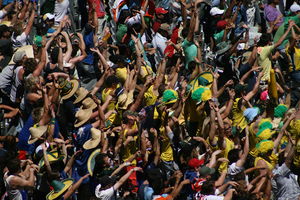
Cricket has a long history in Australia, and is played on local, national and international levels. It is Australia's national summer sport and unlike the various football codes, enjoys consistent support from people in all parts of Australia. It is one of the most popular sport in Australia ,some people say it is the most popular sport. The Australia national cricket team was the winner of the first Test match, and is today regarded as the leading international team in world cricket, having been the unquestionably dominant team for most of the 2000s. The first Australian cricket team which played overseas was the 1868 Aboriginal cricket tour of England. The Australian team which toured England in 1948 was nicknamed The Invincibles and was captained by Donald Bradman. In recent years the Australia team has been captained by Allan Border, Mark Taylor, Steve Waugh, and currently Ricky Ponting. Through 2007, Australia has won the Cricket World Cup four out of the nine times it has been held, including the last three. Australia has dominated world cricket since the mid-90's, it has appeared in every world cup final since 1996, and has been undefeated in world cup matches where they have gone on to win every single world cup match they have since played except for tying South Africa in the 1999 semi-final .
Domestic competitions between the states include the Sheffield Shield first-class competition, the Ford Ranger One Day Cup List-A cricket competition and the KFC Twenty20 Big Bash Twenty20 competition. The Sheffield Shield and Ford Ranger One Day Cup tournaments involve each team playing against each other team both at home and away with the two highest-placed teams playing in a final match, while the KFC Twenty20 Big Bash is similar but with only one match against each other team before the final.
Indoor cricket also has a strong following in all states of Australia. According to indoor cricket's governing body, Cricket Australia, there are over 100 indoor cricket centres across Australia, with more than 200,000 active participants in the sport. Australia has a proud international record in the sport, and winning every Indoor Cricket World Cup since the tournament's interception in the early 1990s.
Cycling
Cycling in Australia is governed by Cycling Australia.
Australia is home to the largest road race outside of Europe, the Tour Down Under, which is held in Adelaide, South Australia. The race begins in January and is the first race in the UCI pro season. Cadel Evans was the first Australian road race world champion when he won the 2009 world championship road race, held in Switzerland.
Australia has also been very successful in Olympic and Commonwealth Games track cycling.
Golf
Australia is a long-standing power in golf and has one of the highest numbers of golf courses per capita in the world. At 31 December 2007 Australia had twelve men in the top one hundred of the Official World Golf Rankings, placing it behind only the United States and slightly ahead of the United Kingdom. The Australian Open was first played in 1904 and is one of the main annual golf tournaments in the PGA Tour of Australasia. One of the best known Australian golfers is Greg Norman, the world's number one ranked golfer for much of the 1980s and 1990s. Also well known are Stuart Appleby, Adam Scott, Steve Elkington, Ian Baker-Finch, Geoff Ogilvy, Nick O'Hern and Karrie Webb. There is a women's professional tour based in Australia called the ALPG Tour. Golf Australia is the National Sporting Organisation for golf in Australia.
In terms of major championships won, Webb leads all Australians with seven majors; she is also the only golfer in history to win five different events recognised as majors by the world's dominant women's tour, the U.S. LPGA. Among men, the most successful in terms of majors was Peter Thomson, who won The Open Championship five times. Other Australian major winners include Jan Stephenson, who won three LPGA majors in the early 1980s; Norman, who won The Open twice; Wayne Grady, who won the US PGA title in 1990; Baker-Finch, who won The Open in 1991; Kel Nagle, who beat Arnold Palmer by one stroke at St Andrews at the 1960 Open Championship; and Ogilvy, who won the U.S. Open in 2006.
No Australian has won the US Masters to date and it remains one of the holy grails of sport in the country. Norman famously came closest to winning when he held a six-stroke lead in 1996 only to be overcome by Nick Faldo on the final day, eventually finishing 5 strokes behind. He also lost the 1987 Masters when Larry Mize miraculously holed a 40-metre pitch shot on the second hole of a sudden-death playoff.
Horse racing
Thoroughbred horse racing is the most attended spectator sport in Australia with almost 2 million admissions to the 379 racecourses throughout Australia in 2002–2003. Australians wager more than $12 billion annually on Thoroughbred races through the Totalizator Agency Board (TAB) and bookmakers.[22] Most of the Australian races are flat races held on turf surfaces. Some hurdle and steeplechases are held during the winter in Victoria and South Australia. Besides being a spectator sport, horse racing is also an industry, which provides full or part time employment for almost 250,000 people, the equivalent of 77,000 jobs. About 300,000 people have a direct interest as owners, or members of syndicates in the 30,000 horses in training in Australia.
Public interest in Thoroughbred racing, especially during the main Spring and autumn racing carnivals, has been growing in recent years with over 100,000 attracted to the running of both the Melbourne Cup and VRC Oaks. The 2008 spring racing carnival attracted nearly 400,000 people over the four main days. The Golden Slipper Stakes, Caulfield Cup and W S Cox Plate are also major attractions.
Throughout its history, horse racing has become part of the Australian culture and has developed a rich and colourful language. The most famous racehorses of Australia's turf include the New Zealand bred Carbine, Phar Lap, and Tulloch, the Australian bred Bernborough, Gloaming and Kingston Town plus the British bred Makybe Diva.[23]
Harness racing is another code of horse racing in Australia. Standardbred horses either trot, in a diagonal gait, or more usually pace (in a lateral gait), along with 8-12 other horses and drivers on a circular racing track over 600 to 1,400 metres. One of the most successful pacers in Australia was the New Zealand bred, Cardigan Bay who won 82 races in all and was the first Standardbred horse to earn (US) one million dollars or more.[24]
Motorsport

Motorsport is a popular spectator sport in Australia, although there are relatively few competitors compared to other sports due to the high costs of competing. The most widely watched motorsport is V8 Supercars, especially at the Bathurst 1000 endurance touring car race. Other classes in Australia include Formula 3 (open wheel racing) and Superbikes, while Karting is popular at amateur and junior levels. Since 1985, Australia have hosted a round of the Formula One championship. For the first 10 years, the Grand Prix was the last round of the championship at Adelaide. Melbourne replaced them from 1996 onwards. In 1988, Australia first hosted a round of the World Rally Championship and continued until 2006. 2009 saw the WRC return to Australia. Both the Motorcycle World Championship and the Superbike World Championship have rounds of their championships held at Phillip Island. Several other international series have visited Australia, including the World Sportscar Championship, IndyCar Series, Champ Car World Series, Asia-Pacific Rally Championship and the Red Bull Air Race World Championship.
The greatest Australian racing driver of all time is Sir Jack Brabham who won the Formula One title in 1959 and 1960 in a Cooper-Climax and adding a third title in 1966 in a Brabham-Repco, the only time the title has been won by a driver in a car he designed. Brabham was runner up in 1967 and won his last Grand Prix in 1970, before retiring and becoming only the second Australian after Don Bradman to be knighted for his services to sport. In 1980 Alan Jones became the only other Australian to win the F1 championship this time driving a Williams-Ford. Michael Doohan is celebrated as one of the best motorcyclists of all time after his five consecutive titles racing Honda NSR500s from 1994–1998. Wayne Gardner also won the title on a NSR500 in 1989 and Casey Stoner become the world champion in 2007, the first rider to win the top division for Ducati. Two Australian riders have won the World Superbike title, Troy Corser (1996 and 2005) and Troy Bayliss (2001, 2006 and 2008). The most successful domestic Touring car driver was Peter Brock, who won the Bathurst 1000 nine times and finished second in the Belgian classic, the Spa 24 Hours.
Netball
- See also Commonwealth Bank Trophy, Netball Australia, ANZ Championship
Netball has the highest level of participation of any team sport in Australia. It rivals cricket, soccer and Australian football for the highest number of participants of any team sport in the country. The game is governed by Netball Australia at the national level, which is responsible for the national team and national competition.
The Australian national netball team, along with traditional rivals New Zealand's Silver Ferns, dominate the game at international level. The main competitions at international level are the Netball World Championships and Commonwealth Games, where Australia recently won the World Crown in 2007.
At the domestic level, elite players previously competed for the now defunct Commonwealth Bank Trophy. Indoor Netball is a fast growing variation of the game, with modified rules. It is popular amongst both men and women with mixed competitions also conducted. A world championship in indoor netball was held in 2001.
In 2008, the ANZ Championship started, consisting of five teams from Australia and New Zealand. The Australian Teams are Melbourne Vixens, West Coast Fever, NSW Swifts, Adelaide Thunderbirds and Queensland Firebirds. The NSW Swifts won the ANZ Championship in 2008, and the Vixens won the championship in 2009, with the Vixens becoming known as "The best netball team in the world".
The most notable Australian netball players, past and present are Sharelle McMahon, Liz Ellis, Eloise Southby-Halbish, Shelley O'Donnell, Natalie von Bertouch, Julie Corletto, Bianca Chatfield, Catherine Cox and many more.
Rugby league

Also referred to as "league", "football" or "footy", rugby league is one of Australia's most popular sports, viewed by more people across the country annually than any other sport.[7] Rugby League dominates the hearts and minds of winter sports followers in New South Wales, Queensland and the ACT with an additional strong presence in the Northern Territory. The Australian Rugby League (ARL) is the governing body for the sport of rugby league football in Australia. It is made up of state bodies, including the New South Wales Rugby League and the Queensland Rugby League.
The National Rugby League is the premier professional competition in Australia and is made up of sixteen teams based in New South Wales, Queensland, Victoria, the Australian Capital Territory and New Zealand. The NRL also runs a National Youth Competition for 17-19 year olds. Second tier leagues also exist and are run according to state lines across Australasia.
State of Origin, a three game series between New South Wales and Queensland is one of the biggest annual sports events in Australia. First played in 1980, the annual series is renowned for the evenness of the competition and the passion of the players and fans. Other blockbuster fixtures during the season also include the NRL All Stars Game, World Club Challenge, City vs Country Origin and the premiership deciding NRL Grand Final - one of the largest club championship games in the world.
The Affiliated States Championship is an annual competition run by the ARL involving the four affiliated states (Victoria, South Australia, Northern Territory and Western Australia) plus the Australian Police Rugby League and Australian Defence Force. It has been running since 1994 and Western Australia has shown a clear dominance, winning 5 times.
The Australian Kangaroos represent Australia internationally in the sport of rugby league and are one of Australia's most successful teams, having lost only a handful of major international tournaments and being ranked firmly at number one by the RLIF over the past several years. See also List of results of the Australian national rugby league team.
Australia is involved in a number of competitions between national rugby league sides. The Four Nations is a rugby league tournament involving the top three nations in the sport: Australia, New Zealand and Great Britain, which started in 1999. A fourth opponent is alternated biannually from the winners of either the European or Pacific Cup International qualification tournaments. The Rugby League World Cup has been held since 1954, which Australia has won on 8 occasions out of the 11 tournaments so far, in '57, '68, '70, '77, '88, '92, '95 and 2000. Australia has only missed the final once, in 1954.
In 2009, rugby league's popularity in Australia was confirmed as, for the first time ever, it had the highest aggregate television ratings of any sport[7]. The following year it also set a new all time regular season attendance record.[25]
Rugby union
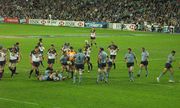
The first recorded game of Rugby football in Australia was on 25 July 1839. The Sydney University club, the first recognised club, was formed in 1864. By 1874 there were enough clubs for the formation of the Sydney Metropolitan competition playing by the rules of the Rugby Football Union.
English teams toured Australia in 1888 and 1899. Throughout the 20th century Australian Rugby Union teams were reliably competitive. In Australia, rugby union became a professional sport in 1996. The Australia national rugby union team are the Wallabies. Major international competitions played by the Wallabies include the Bledisloe Cup, between Australia and New Zealand, which since 1996 has been part of the Tri Nations Series.
The Rugby World Cup was first held in 1987 and is now held every four years. Australia won the Rugby World Cup twice, in 1991 and 1999. The Mandela Challenge Plate began in 2000, which started as a minor tournament involving Australia and South Africa. From 2006 on, it will be contested in the Tri Nations alongside the Bledisloe Cup.
The premier provincial rugby competition is Super Rugby, originally known as Super 12, later Super 14, and, starting in 2011, Super 15. From 2011 it will consist of 5 teams from each of the three strongest nations in Southern Hemisphere rugby—Australia, New Zealand and South Africa. The Melbourne Rebels will join the competition in 2011 alongside the country's previously existing teams—the Queensland Reds, New South Wales Waratahs, Brumbies (representing the ACT and southern New South Wales) and Western Force (representing Western Australia). Of all the Australian teams, only the Brumbies have won a Super Rugby title, in 2001 and 2004.
The Australian Rugby Shield was first played in 2000, to try and promote rugby union in states outside New South Wales and Queensland. To celebrate 10 years of professional Rugby Union, Australian Rugby celebrated the occasion with the announcement of the Wallaby Team of the Decade.
Association football (soccer)

Association football (soccer) is the only code of football that appears in the Australian top ten sports and physical recreational Activities by participation.[26]
Australia's national team, nicknamed the Socceroos, are active in international games and in 2009 were one of the first teams to qualify for the FIFA World Cup in South Africa, 2010. The governing body in Australia, Football Federation Australia, is a member of the Asian Football Confederation, having moved from the Oceania Football Confederation on 1 January 2006. They famously thrashed American Samoa 31-0, a world record, in a 2002 World Cup qualifying match.
The popularity of the sport as a spectator sport has increased in recent years (some claiming the sport has gone mainstream, some claiming popularity is nearing an end[21]), due to reforms made to the sport's national governing body and the participation of the national team in the 2006 FIFA World Cup, their first in 32 years. Led at the time by coach Guus Hiddink from the Netherlands, they surprised many by reaching the Round of 16, losing 1-0 to the eventual champions Italy courtesy of a dubious penalty.[27] The "Socceroos" have consistently been ranked inside the top fifty in The FIFA World Ranking as of July 2010 at 20 (and 16 for the "Matilda's" the women's national team).
The year 2004 marked the last season for the National Soccer League, Australia's first club based national league of any sport and in 2005 the A-League was launched. The A-League plays during summer, the traditional off-season, to avoid conflict with the more established football codes in publicity and facilities as well as being in line with European competition.
The A-League started off successful, with the 2006-07 regular season recording an average attendance of 12,927 people, although crowds are now dropping.[28] Most notably, Melbourne Victory averaged 27,728 people to their home matches (reduced to 21,105 for the 2009-10 regular season[29]) throughout the season with a season record home-and-away crowd of 50,333 against Sydney FC at Docklands Stadium on Dec 8th, and a crowd of 55,436 watched the Victory beat Adelaide United 6-0 in the Grand Final, a record for a domestic club football (soccer) game in Australia.[30] The 2010 Grand Final between Sydney FC and Melbourne (also played at Docklands Stadium) drew 44,560, over 10,000 less than Melbourne's first Grand Final.[31] The 2009-10 regular season was considerably lower[32] with an average attendance of 9,796.
Historically, the sport has been known by many as soccer, but numerous official organisations, clubs and media companies are now using the name "football" in line with common international usage of the word. However, popular use of the word "football" to mean either Australian rules football, rugby league and rugby union is well-established in Australia. (See also: The word "football" in Australia).
Softball
Australia's softball history began in 1939 when Gordon Young, Director of Physical Education in NSW, began to promote the game in schools and colleges. In 1942, during World War II, a US Army Sergeant, William Duvernet, organised softball as a recreation for US nurses stationed in Victoria. Another American, Max Gilley, introduced the game to Queensland in 1946. Australia's first inter-state championship was played in Brisbane in 1947 and was won by Victoria. The second national championship was held in Melbourne two years later. It was at this championship that the Australian Softball Federation was formed with Queensland, Victoria, South Australia and New South Wales being the founding members. The other States of Australia have since joined. Eight Australian Championships are now conducted each year - Open Women's, Open Men's, Under 23 Women and Men, Under 19 Women and Men, and Under 16 Girls and Boys. Softball has been a major sport in the schools program for some time now and it is estimated that more than 250,000 children play the game each year.
Swimming
Swimming is a very common and popular sport in Australia as a recreational activity as well as in competitive racing events. Many Australians learn to swim from a young age out of necessity due to Australia's love of the beach and the abundance of backyard pools. Many swimmers go on to continue to swim competitively by training through squads and attending weekend competitions. Successful Australian swimmers such as Ian Thorpe began their swimming careers through a learn to swim program. Learn to swim programs are also often offered through primary schools.
Tennis
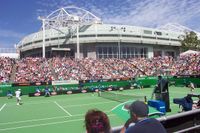
Australia's first lawn tennis court was build on Garden Island on Sydney Harbour in 1880. It is still in use.[33][34][35]
One of the world's four tennis Grand Slam events is played in Australia, the Australian Open held in Melbourne. The tournament has been held for over 100 years, since 1905 when the Australasian Tennis Championship was first held at a Cricket Ground in St Kilda Road, Melbourne. Like the other three Grand Slam events, it was contested by top-ranked amateur players. It was known as the Australian championships until the advent of open tennis in 1968. There are men's and women's singles competitions, men's, women's, and mixed doubles, as well as junior and master's competitions. There are numerous other tournaments, such as the Medibank International in Sydney.
Some of Australia's best known tennis players include Rod Laver, Mark Philippoussis, Margaret Court, Roy Emerson, Lleyton Hewitt, John Newcombe, Evonne Goolagong-Cawley, Pat Rafter, Ken Rosewall Samantha Stosur, Jelena Dokić, Alicia Molik and The Woodies. The Woodies, consisting of Todd Woodbridge and Mark Woodforde, was the most successful men's tennis doubles team in history, and won eleven Grand Slam events and an Olympic gold medal.
Of the 'real tennis' game, the current real tennis world champion is Robert Fahey from Hobart, Australia. Fahey is the longest serving champion of real tennis.
Touch football
Touch Football, owing to its origination from the sport of Rugby League, has a very strong following in Australia, mainly in the traditional Rugby League strongholds of Queensland and New South Wales, but also in the ACT and more recently, Victoria and Western Australia.
The Touch Football Australia (TFA) National Touch League (NTL) features teams from 13 regions around the country competing in 12 divisions from Mens, Women's and Mixed Open to Over 40's Women's and Over 50's Mens.
Australia has claimed every Touch Football World Cup since the inaugural event was held on the Gold Coast, Queensland in 1988.
Winter sports
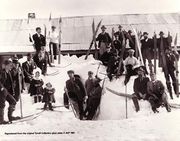
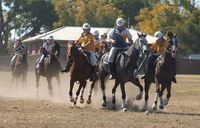
Australia receives snow in the Australian Alps and parts of Tasmania, and has indoor ice rinks in many cities. As a result, Australians are able to participate in a wide variety of winter sports, including skiing, snowboarding, cross-country skiing, biathlon, freestyle skiing (including aerial skiing and moguls), ice hockey, curling, short track speed skating and figure skating. Australia has Olympic programs for some of these sports. Australia has little or no facilities for ski jumping, and the ski runs are mostly too short for the faster competitive alpine skiing events like Super-G and Downhill. There are no bobsleigh tracks (used for bobsleigh, luge and skeleton) within Australia (the nearest one is in Japan), although Australia competes in slide events overseas, and there is a bobsleigh push track in the Docklands in Melbourne. [1]
Australians participated in skiing as a sport from the 19th century, probably starting in Kiandra in 1861. The first indoor ice rink was probably opened in 1889, and another opened in Adelaide in 1903. Ice hockey was played as early as 1904.
The Mount Buller World Aerials is an aerial skiing event held in Mount Buller, Victoria. It is the first event in the World Cup calendar.
The Kangaroo Hoppet is a 42 km cross-country skiing race held in Falls Creek, Victoria. Held at the same time are the 21 km Australian Birkebeiner and the 7 km Joey Hoppet races. The Kangaroo Hoppet and the Australian Birkebeiner are part of the Worldloppet series of cross-country ski races.
A team of women competing in skeleton was created from athletes who had never competed in the sport before, planning to win a medal at the 2006 Winter Olympics.
Australians developed the equine team sport of Polocrosse which is now played internationally.
Short track speed skating is governed by the Australian Amateur Ice Racing Council which is also responsible for encouraging interstate competitions such as the Duke Trophy.
Other sports
Olympic Sports
- Archery - is conducted by Archery Australia: Australia's most successful international archer has been former World and Olympic champion, Simon Fairweather [36].
- Badminton - the first competition in Australia was played in 1900 and the sport is governed by Badminton Australia[37]
- Boxing - Boxing Australia is the peak body for Olympic or amateur boxing[38].
- Canoeing and Kayaking - Canoeing and Kayaking Australia is the peak body for these sports, first founded in 1949[39], with Australians winning 15 Olympic medals [40].
- Diving - Dick Eve won Australia's first Olympic diving gold medal in 1924[41]. Diving Australia is responsible for administration and development of the sport[42].
- Dressage - an equestrian event conducted by the Equestrian Federation of Australia [43].
- Eventing - a most successful sport for Australia at recent Olympic Games, equestrian events are conducted by the Equestrian Federation of Australia [43].
- Fencing - governed by the Australian Fencing Federation[44].
- Gymnastics is a popular sport amongst girls and has recently had an increase in participation by boys. It governed by Gymnastics Australia and now has over 120,000 members.[45]. Traditionally, Australia has struggled on the international stage, but in recent years has started to have some success with the women's team getting the bronze medal at the 2003 world championships and in 2006 Philippe Rizzo became Australia's first ever world champion on the Horizontal Bar.
- Hockey - Australia's national team has performed well in recent Olympics, coming first in 2004 and third in 2008. It is governed by Hockey Australia.
- Judo - first demonstrated in Australia in 1906 and now governed by the Australian Judo Federation[46] which runs the annual Australian National Judo Championships.
- Modern Pentathlon - a multi-sport featuring athletics, swimming, fencing, shooting and equestrian events[47].
- Rowing is a traditionally popular sport in Australia, with the peak body Rowing Australia[48]
- Shooting is popular in Australia, with over 765,000 licenced shooters at August 2007. Internationally, Australia has performed well, with Michael Diamond winning numerous medals in the Olympics and Commonwealth Games. The largest shooting sports organisation in the country is the Sporting Shooters' Association of Australia, with over 120,000 members[49]
- Showjumping - an equestrian event conducted by the Equestrian Federation of Australia [43].
- Table tennis - a popular pastime as well as an Olympic sport, administered by Table Tennis Australia[50]
- Taekwondo - Taekwondo Australia[51] conducts Australian events.
- Team handball - a minor sport in Australia, administered by Handball Australia [52]
- Triathlon, a multi-sport comprising swimming, cycling and running events of varying distances, Triathlon Australia is the governing body[53].
- Volleyball - Australia has had international success in Beach volleyball. The Australian Volleyball Federation is the peak Australian body[54].
- Water Polo - Australian teams have had success at the Olympic Games and World Championships. Australian Water Polo is the governing body[55].
- Weightlifting - conducted by the Australian Weightlifting Federation[56]/
- Wrestling - Despite being a minor sport, Australian wrestlers have won three Olympic medals[57].
- Yachting - Yachting Australia is responsible for sailing in Australia[58] with Australia winning the America's Cup in 1983.
Beach Sports
Beach sports are very popular in Australia, due to climate and culture:
- Ironman
- Surf lifesaving
- Surfing
- Beach Touch
Games and Pastimes
- Darts - Townsville's Tony David was the 2002 BDO World Champion and the first ever Australian to win a darts title.
- English Billiards - Walter Lindrum from is often referred to as the greatest player so far seen in this sport with some 57 world records to his credit, many still standing. He won the World Billiards Championship in 1933 and held it until his retirement in 1951. Lindrum is also often referred to as one of the Australian all-time great sporting heroes along with Donald Bradman and Hubert Opperman. At his death in 1960, newspapers called him "the Bradman of Billiards".
- Fishing
- Skateboarding - Skateboarding is the act of riding on and performing tricks with a skateboard. A person who skateboards is referred to as a skateboarder or skater.
- Snooker is not particularly popular in Australia but Melbourne's Neil Robertson in the 2006-07 season became the first Australian to win three major ranking titles: The Grand Prix in October, the Welsh Open in February and Bahrain Championship in 2008-2009. The following season he won the Grand Prix and the Betfred.com World Championship. Other past players have included Horace Lindrum who was World Champion in 1952 and lost to Joe Davis, three times during the 1930s, Eddie Charlton who was twice a World Championship finalist and of recent players, Quinten Hann. The World Snooker Championship has also been held in Australia twice in 1971 and 1975.
Minor Sports
- Amateur Radio Direction Finding is a sport that combines the skills of orienteering with the skills of radio direction finding. Although an obscure sport to most, Australia has had great success at Asia/Pacific regional competitions. ARDF events in Australia are organised by local clubs and the national team is organised by the Wireless Institute of Australia.
- Bandy has only existed a few years in Australia. It's played by 8 Senior (including 16 women) and 4 Junior teams in Sydney and Australian Capital Territory. The interest for bandy came about after seeing broadcasts on Eurosport 2. The Australian Bandy Federation[2] has been a part of the Federation of International Bandy since 2006. It's in the process of starting a national team for men, and if the rules allow it, they plan to participate in the Asian Winter Games 2011 in Astana-Almaty.
- Bocce is a varied cross between lawn bowls and tenpin bowling, played at many lawn bowls clubs
- Broomball
- Calisthenics is a uniquely Australian sport for both boys and girls. It is an artistic sport set mainly in competition on theatre stages. It involves several different styles of work that can be done including singing, dancing, apparatus work and gymnastics. LINK; www.calisthenics.asn.au
- Campdrafting An equestrian sport developed in Australia and now has a wide following.
- Downball - Two main versions: wall version ("rebound handball") and four square - both are extremely popular among young people Australia-wide
- Gaelic football is a growing sport among men and women for both Irish expatriates and Australians and is governed by the Gaelic Athletic Association of Australasia and several state bodies.
- Gliding
- Gridiron, otherwise known as American football or Canadian Football.
- Handball - founded in Australia in 1847: mainly the three wall version administered by the Australian Handball Council[59].
- Hurling - game of Irish origin - has similarities to field hockey and lacrosse. As Gaelic football, governed by the Gaelic Athletic Association of Australasia
- Ice hockey including the Australian Ice Hockey League
- International Rules Football is a compromise rules game played in tests at club level between Australian rules football and Gaelic football teams and at international level between Australia and Ireland.
- Korfball, a Dutch sport similar to netball and basketball, has league competitions in some states, and a national team who finished 8th out of 16 qualifiers at the 2007 World Championships and have consistently finished second (behind Chinese Taipei) in senior and junior Asia-Oceania championships.
- Lacrosse is a sport played by relatively few people in Australia, but is one of the oldest established sports in the country, having been introduced in 1875. The national teams have been successful too, with the women's national team winning the World Cup in 1986 and again in 2005, while the men's team have been runners-up on a number of occasions.
- Lawn Bowls a game of considerable popularity in Australia. Although traditionally associated with older people, sufficient young play to render Australia as one of the dominant forces in international competition. There are lawn bowls clubs in most towns. In recent years it has grown in popularity among younger people and has appeared in popular culture in television shows and movies like Crackerjack and The Secret Life of Us
- Orienteering is a sport that combines cross-country running with land navigation skills in the woods. Orienteering in Australia is organised by Orienteering Australia [3].
- Polo An equestrian sport.
- Rodeos
- Rounders is played mainly at Primary School level.
- Tenpin Bowling was a popular minority sport, but is now a small social pastime.
- Trugo is a sport unique to Australia, played by a small number of Australians.
- Ultimate, with Australian teams placing third in the 2004 world championships,[60] and second in 2005[61]. Australian ultimate is governed by the Australian Flying Disc Association.
- Vigoro is a game resembling both cricket and baseball mainly played by women.
Commonwealth Games
Australia is one of the nations to have attended every British Empire/Commonwealth Games event. It has been hosted four times in Australia:
- 1938 British Empire Games - Sydney
- 1962 British Empire and Commonwealth Games - Perth
- 1982 Commonwealth Games - Brisbane
- 2006 Commonwealth Games - Melbourne
Australia has had huge success at the Commonwealth Games. At the 2006 Commonwealth Games in Melbourne, Australia walked away with 84 gold, 69 silver, and 68 bronze medals. The next closest nation, England, secured 34 gold medals.
Olympic Games
Two Olympic Games have been held in Australia; the 1956 Summer Olympics in Melbourne and the 2000 Summer Olympics in Sydney. Australia is one of only three countries to have sent athletes to every Summer Olympic Games. Australia is also currently the only southern hemisphere country to have won a gold Olympic medal in the Winter Olympics. The most successful Australian athlete at an Olympics in terms of medals won is Ian Thorpe with nine medals, with five of them gold. Athletes who have achieved four gold medals were: Betty Cuthbert, Murray Rose, Dawn Fraser and Shane Gould.[62]
The most medals Australia has won at an Olympics was at Sydney 2000, with 58 medals, with 16 of them gold. It was also the largest team Australia has had at an Olympics with 630 athletes, helped by the home country's automatic qualification into every sport. The most gold medals Australia has won at an olympics were at Athens 2004, with 17.
See also
- Aussie Aussie Aussie, Oi Oi Oi
- Australia-New Zealand sporting relations
- Australian Sports Commission
- Australian Institute of Sport
- Australian University Games
- Australian national sports team nicknames
- Sledging (cricket)
- Skiing in Australia
- Tent boxing, old Australian tradition of fighting
References
- ↑ Australian Bureau of Statistics, "4147.0 - Sport and Recreation Funding by Government, Australia, 2000-01"
- ↑ Australian Bureau of Statistics, "4174.0 - Sports Attendance, Australia, 2005-06".
- ↑ Sweeney Sports, "1. Cricket captures ‘most interest’ cap 2. Swimming slips to second place 3. Tennis rebounds 4. AFL continues to fend soccer"
- ↑ Australian Bureau of Statistics, "4177.0 - Participation in Sports and Physical Recreation, Australia, 2005-06"
- ↑ Home Teams
- ↑ "Arrogant Ponting must be fired". The Sydney Morning Herald. 8 January 2008. http://www.smh.com.au/news/cricket/arrogant-ponting-must-be-fired/2008/01/07/1199554571883.html.
- ↑ 7.0 7.1 7.2 Newstalk ZB (2009-12-21). "League becomes Australia's top sport". TVNZ (New Zealand: Television New Zealand Limited). http://tvnz.co.nz/rugby-league-news/league-becomes-australia-s-top-sport-3315931. Retrieved 2009-12-24.
- ↑ About Australia: Sporting Excellence. Department of Foreign Affairs and Trade website
- ↑ "Cricket Australia introduces tough drug". http://in.news.yahoo.com/071102/48/6mqd2.html.
- ↑ Athletics Australia - Annual Report 2006/07
- ↑ Athletics Australia - History
- ↑ Athletics Australia selection criteria
- ↑ Australia Post Stawell Gift
- ↑ AFL, "All-time attendance record for 2008" (29 September 2008) Access date: 30 September 2008.
- ↑ More chase Sherrin than before - realfooty.com.au
- ↑ http://www.ausport.gov.au/scorsresearch/ERASS2005/ERASS2005_findings.pdf Participation in Exercise, Recreation and Sport Survey 2005 Annual Report
- ↑ IBAF
- ↑ http://www.nbl.com.au/index.php?id=959
- ↑ http://www.geelongadvertiser.com.au/article/2010/07/01/187051_geelong_sports.html
- ↑ http://www.heraldsun.com.au/news/victoria/basketball-is-most-popular-sport/story-e6frf7kx-1225884928551
- ↑ 21.0 21.1 http://www.heraldsun.com.au/opinion/just-a-soccer-ruse/story-e6frfhqf-1225886397854
- ↑ Racing Fact Book
- ↑ de Bourg, Ross, "The Australian and New Zealand Thoroughbred", Nelson, West Melbourne, 1980, ISBN 0 17 005860 3
- ↑ Cardigan Bay Retrieved on 3 June 2009
- ↑ "Attendance Record". National Rugby League. http://www.nrl.com/news/news/newsarticle/tabid/10874/newsid/60086/telstra-premiership-sets-new-attendance-record/default.aspx.
- ↑ Australian Bureau of Statistics catalogue no. 4177.0 - Participation in Sports and Physical Recreation, Australia, 2005-06
- ↑ http://fifaworldcup.yahoo.com/06/en/w/bracket.html
- ↑ http://www.foxsports.com.au/story/0,8659,26143627-5000940,00.html
- ↑ 2006-07 regular season
- ↑ Chris Johnston (2007-01-19). "Joy of six". The Age. http://www.theage.com.au/news/soccer/v-for-archie/2007/02/18/1171733613365.html. Retrieved 2007-08-09.
- ↑ Lynch, Michael (21 March 2010). "Party time for Sydney as Muscat fluffs it". The Sydney Morning Herald. http://www.smh.com.au/sport/football/party-time-for-sydney-as-muscat-fluffs-it-20100320-qndg.html.
- ↑ http://www.insidefutbol.com/2009/10/25/australian-a-league-suffering-attendance-decline/11426/
- ↑ Elbourne, Sean (Winter 2006). "Wonderful Kuttabul - a long history of service" (PDF). Sea Talk (Winter 2006) (Royal Australian Navy): pp. 11–19. http://www.navy.gov.au/w/images/Sea_Talk_2006-autumn.pdf. Retrieved 2008-09-07.
- ↑ "Island's tourism birth a date with history". The Sydney Morning Herald. http://www.smh.com.au/articles/2002/11/21/1037697802931.html.
- ↑ "Garden Island Information". http://www.ausemade.com.au/nsw/destination/g/garden-island/garden-island.htm.
- ↑ Archery Australia Hall of Fame
- ↑ Badminton Australia - History of Badminton in Australia
- ↑ Boxing Australia website
- ↑ MenuID=AC_Information/93/0/,Australian_Canoeing_History/69/0/ Canoeing and Kayaking Australia - History
- ↑ Canoeing and Kayaking Australia - Olympic history
- ↑ Australian Diving Hall of Fame
- ↑ Diving Australia website
- ↑ 43.0 43.1 43.2 Equestrian Federation of Australia website
- ↑ [http://www.ausfencing.org/ Australian Fencing Federation website]
- ↑ Gymnastics Australia website
- ↑ Australian Judo Federation - History
- ↑ Modern Pentathlon Australia - History
- ↑ Rowing Australia website
- ↑ Sporting Shooters Association of Australia website
- ↑ Table Tennis Australia
- ↑ Taekwondo Australia website
- ↑ Handball Australia website
- ↑ Triathlon Australia website
- ↑ Australian Volleyball Federation website
- ↑ Australian Water Polo website
- ↑ Australian Weightlifting Federation
- ↑ Australian Olympic Committee - Wrestling
- ↑ Yachting Australia website
- ↑ Australian Handball Council website
- ↑ WFDF 2004 World Ultimate & Guts Championships
- ↑ WFDF at The World Games 2005: News
- ↑ Ian Thorpe - Australia's Most Successful Olympian Has Retired from Swimming
External links
- I Wanna Play - Australia's Premier online Sports Club Directory
- Australian Sports Commission
- Australian Institute of Sport
- Austadiums.com: Stadiums & Sport
- SportsAustralia.com
- Unisport
- Unigames
- Indoor Netball Australia
- Australian Sporting quotes
|
|||||||||||
|
|||||||||||
|
|||||||||||||||||||||||||||||